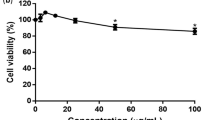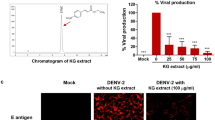Abstract
Dengue fever is caused by the Aedes mosquito-borne dengue virus, which is a global threat with 400 million cases reported annually and 5–20% mortality rate. Currently, there is no effective treatment available for dengue fever. Natural products like withanolides, which are steroidal lactones, have shown many good properties, including antiviral activity against other viruses. This study aimed to evaluate the anti-dengue virus serotype 2 activity of withanolide A and withanone in Vero cells. Withanolide A and withanone were well-tolerated in Vero cells with a half-maximal cytotoxic concentration of 0.4982 and 1.186 µM, respectively. Withanolide A and withanone exhibited good direct virus-inactivating effects against dengue virus serotype 2 with a half-maximal inhibitory concentration of 0.017 and 0.353 µM, respectively. Based on the selectivity index, withanolide A (selectivity index, 29.31) was determined to be safer and more effective in inhibiting dengue virus serotype 2 infection in Vero cells than withanone (selectivity index, 3.36). Further investigations conducted with withanolide A showed that it inhibited dengue virus serotype 2 during the pre- and post-infection stages in a dose-dependent manner. Withanolide A also effectively blocked dengue virus serotype 2 attachment and entry into Vero cells in a dose-dependent manner. These findings suggest that withanolide A showed potent anti-dengue activity and could serve as a promising antiviral agent for treatment of dengue infections.
Graphical abstract






Similar content being viewed by others
References
Abdul Ahmad SA, Palanisamy UD, Tejo BA, Chew MF, Tham HW, Syed Hassan S (2017) Geraniin extracted from the rind of Nephelium lappaceum binds to dengue virus type-2 envelope protein and inhibits early stage of virus replication. Virol J 14:229. https://doi.org/10.1186/s12985-017-0895-1
Abubakar S, Puteh SEW, Kastner R, Oliver L, Lim SH, Hanley R, Gallagher E (2022) Epidemiology (2012–2019) and costs (2009–2019) of dengue in Malaysia: a systematic literature review. Int J Infect Dis 124:240–247. https://doi.org/10.1016/j.ijid.2022.09.006
Alves RR, Rosa IM (2007) Biodiversity, traditional medicine and public health: where do they meet? J Ethnobiol Ethnomed 3:14. https://doi.org/10.1186/1746-4269-3-14
Balkrishna A, Pokhrel S, Singh H, Joshi M, Mulay VP, Haldar S, Varshney A (2021) Withanone from Withania somnifera attenuates SARS-CoV-2 RBD and host ACE2 interactions to rescue spike protein induced pathologies in humanized zebrafish model. Drug Des Devel Ther 15:1111–1133. https://doi.org/10.2147/DDDT.S292805
Bhatt S, Gething PW, Brady OJ, Messina JP, Farlow AW, Moyes CL, Drake JM, Brownstein JS, Hoen AG, Sankoh O, Myers MF, George DB, Jaenisch T, Wint GRW, Simmons CP, Scott TW, Farrar JJ, Hay SI (2013) The global distribution and burden of dengue. Nat 496:504–507. https://doi.org/10.1038/nature12060
Chopra A, Srikanth N, Patwardhan B, Group ACR (2021) Withania somnifera as a safer option to hydroxychloroquine in the chemoprophylaxis of COVID-19: results of interim analysis. Complement Ther Med 62:102768. https://doi.org/10.1016/j.ctim.2021.102768
de Souza GE, Bueno RV, de Souza JO, Zanini CL, Cruz FC, Oliva G, Guido RV, Aguiar AC (2019) Antiplasmodial profile of selected compounds from Malaria Box: in vitro evaluation, speed of action and drug combination studies. Malar J 18:447. https://doi.org/10.1186/s12936-019-3069-3
Fabricant DS, Farnsworth NR (2001) The value of plants used in traditional medicine for drug discovery. Environ Health Perspect 109:69–75. https://doi.org/10.1289/ehp.01109s169
Figueiredo GG, Coronel OA, Trabuco AC, Bazán DE, Russo RR, Alvarenga NL, Aquino VH (2021) Steroidal saponins from the roots of Solanum sisymbriifolium Lam. (Solanaceae) have inhibitory activity against dengue virus and yellow fever virus. Braz J Med Biol Res 54:e10240. https://doi.org/10.1590/1414-431X2020e10240
Galm U, Shen B (2007) Natural product drug discovery: the times have never been better. Chem Biol 14:1098–1104. https://doi.org/10.1016/j.chembiol.2007.10.004
Jain J, Narayanan V, Chaturvedi S, Pai S, Sunil S (2018) In vivo evaluation of Withania somnifera-based Indian traditional formulation (Amukkara Choornam), against chikungunya virus-induced morbidity and arthralgia. J Evid-Based Integr Med 2018:23. https://doi.org/10.1177/2156587218757661
Kumar V, Dhanjal JK, Bhargava P, Kaul A, Wang J, Zhang H, Kaul SC, Wadhwa R, Sundar D (2022) Withanone and Withaferin-A are predicted to interact with transmembrane protease serine 2 (TMPRSS2) and block entry of SARS-CoV-2 into cells. J Biomol Struct Dyn 40:1–13. https://doi.org/10.1080/07391102.2020.1775704
Kurapati KRV, Atluri VSR, Samikkannu T, Nair MPN (2013) Ashwagandha (Withania somnifera) reverses β-amyloid1-42 induced toxicity in human neuronal cells: implications in HIV-associated neurocognitive disorders (HAND). PLoS ONE 8:e77624. https://doi.org/10.1371/journal.pone.0077624
Low ZX, OuYong BM, Hassandarvish P, Poh CL, Ramanathan B (2021) Antiviral activity of silymarin and baicalein against dengue virus. Sci Rep 11:21221. https://doi.org/10.1038/s41598-021-98949-y
Mirjalili MH, Moyano E, Bonfill M, Cusido RM, Palazón J (2009) Steroidal lactones from Withania somnifera, an ancient plant for novel medicine. Mol 14:2373–2393. https://doi.org/10.3390/molecules14072373
Mofed D, Ahmed W, Zekri A, Said O, Rahouma M, Faraag HI (2020) The antiviral efficacy of Withania somnifera (Ashwagandha) against vepatitis C virus activity: in vitro and in silico study. Adv Microbiol 10:463–477. https://doi.org/10.4236/aim.2020.109035
Pritchett JC, Naesens L, Montoya J (2014) Treating HHV-6 infections: the laboratory efficacy and clinical use of anti-HHV-6 agents. In: Flamand L, Lautenschlager I, Krueger GRF, Ablashi DV (eds) Human herpesviruses HHV-6A, HHV-6B & HHV-7, 3rd edn. Elsevier, Boston, pp 311–331
Wilder-Smith A, Yoon IK (2016) Edging close towards the goal of a dengue vaccine. Expert Rev Vaccines 15:433–435. https://doi.org/10.1586/14760584.2016.1154459
Zandi K, Teoh BT, Sam SS, Wong PF, Mustafa MR, Abubakar S (2012) Novel antiviral activity of baicalein against dengue virus. BMC Complement Med Ther 12:214. https://doi.org/10.1186/1472-6882-12-214
Zandi K, Lim TH, Rahim NA, Shu MH, Teoh BT, Sam SS, Danlami MB, Tan KK, Abubakar S (2013) Extract of Scutellaria baicalensis inhibits dengue virus replication. BMC Complement Med Ther 13:91. https://doi.org/10.1186/1472-6882-13-91
Funding
This work was financially supported by the Sunway University research grants, project no. GRTIN-IGS-CVVR[S]-03–2022 and GRTIN-IGS(02)-CVVR-13–2023.
Author information
Authors and Affiliations
Contributions
LAQ conducted the experiments. LAQ and MFL contributed in writing the manuscript. LAQ and MFL analyzed and interpreted the data. YSW conceptualized and designed the study. YSW, CLP, KB, NA, NKF, SF, MS, VS, MRS, and RMG edited and revised the manuscript. All authors have read and approved the final version of the manuscript.
Corresponding author
Ethics declarations
Competing Interests
The authors declare no competing interests.
Rights and permissions
Springer Nature or its licensor (e.g. a society or other partner) holds exclusive rights to this article under a publishing agreement with the author(s) or other rightsholder(s); author self-archiving of the accepted manuscript version of this article is solely governed by the terms of such publishing agreement and applicable law.
About this article
Cite this article
Al Quwatli, L., Lee, M.F., Wu, Y.S. et al. Antiviral Activity of Withanolide A Against Different Infectivity Phases of Dengue Virus Serotype 2 in Vero Cell Line. Rev. Bras. Farmacogn. 34, 609–617 (2024). https://doi.org/10.1007/s43450-023-00510-7
Received:
Accepted:
Published:
Issue Date:
DOI: https://doi.org/10.1007/s43450-023-00510-7




